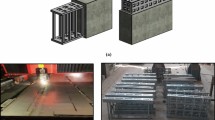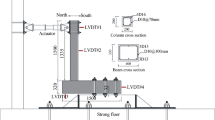Abstract
Many bridges are made from multi-simple spans and can be enhanced by transforming into a continuous girder. An experimental program investigated the transformation of the simply supported girder to a continuous girder using the ultra-high performance concrete (UHPC) joint. The transformation process was presented by arranging a negative reinforcement and cast in place the deck with joints to ensure the continuity of the segment through the interior support. This study presents the material properties, preparation of specimens, the cast of normal strength concrete (NSC) and UHPC, and tested the girder with a point load. The parameters of this study included the support condition, type of joint, hybridization of top reinforcement, and type of load (monotonic and cyclic load). The results showed that the continuous support increased the load-carrying capacity by about 21.4% and reduced the service mid-span deflection by about 24.3% concerning simply supported having the same clear span and section geometry. The effect of using the shear key and carbon fiber reinforced polymer CFRP rebar was presented. This study discussed failure mode, cracking propagation, initial stiffness, and flexural ductility to understand the structural behavior of continuous splice girder. As a result of these investigations, suggestions were identified for future research.
Similar content being viewed by others
References
ACI 318–19 (2019) 318M-19: Building Code Requirements for Concrete and Commentary.
AL-Khafaji AGA, Al-Mamoori AHN, Aoun AMA (2018) Improvement of flexural strength of precast concrete spliced girder using reactive powder concrete in splice region. Structures 14(2017):197–208, DOI: https://doi.org/10.1016/j.istruc.2018.03.012
Al-Quraishy HQA (2012) Experimental and theoretical investigations for behavior of precast concrete girders with connections. Journal of Engineering 18(5):621–638
Al-Sherrawi MH, Allawi AA, AL-Bayati BH, Gharawi MA, El-Zohairy A (2018) Behavior of precast prestressed concrete segmental beams. Civil Engineering Journal 4(3):488, DOI: https://doi.org/10.28991/cej-0309109
Arafa A, Farghaly AS, Ahmed EA, Benmokrane B (2016) Laboratory testing of GFRP-RC panels with UHPFRC joints of the nipigon river cable-stayed bridge in northwest ontario, Canada. Journal of Bridge Engineering 21(11):05016006, DOI: https://doi.org/10.1061/(asce)be.1943-5592.0000943
ASTM C1856 (2017) Standard practice for fabricating and testing specimens of ultra-high performance concrete. ASTM International i:4, DOI: https://doi.org/10.1520/C1856
Baumgart E (2000) Stiffness—an unknown world of mechanical science Injury. May; 31 Suppl 2:S–B14–23. PMID: 10853758, DOI: https://doi.org/10.1016/s0020-1383(00)80041-8
Bertola NJ, Trinh NT, Garcia E, Brühwiler E (2022) Experimental investigation of a keying joint cast in UHPFRC between precast UHPFRC bridge elements. Materials and Structures 55(3), DOI: https://doi.org/10.1617/s11527-022-01931-x
Cao Q, Zhou J, Gao R, Ma ZJ (2017) Flexural behavior of expansive concrete beams reinforced with hybrid CFRP enclosure and steel rebars. Construction and Building Materials 150:501–510, DOI: https://doi.org/10.1016/j.conbuildmat.2017.05.222
Casanova M, Clauson C, Ebrahimpour A, Mashal M (2019) High-early strength concrete with polypropylene fibers as cost-effective alternative for field-cast connections of precast elements in accelerated bridge construction. Journal of Materials in Civil Engineering 31(11): 04019266, DOI: https://doi.org/10.1061/(asce)mt.1943-5533.0002927
CSA (2004) Design of Concrete Structures
Dai JG, Huang CK (2001) Research on the basic mechanical properties of steel fiber reinforced self-stressing concrete. Journal of Building Materials 4(1):70–74 (in Chinese)
Graybeal BA (2007) Compressive behavior of ultra-high-performance fiber-reinforced concrete. ACI Materials Journal 146(104)
Graybeal B, Brühwiler E, Kim BS, Toutlemonde F, Voo YL, Zaghi A (2020) International perspective on UHPC in bridge engineering. Journal of Bridge Engineering 25(11):04020094, DOI: https://doi.org/10.1061/(asce)be.1943-5592.0001630
Graybeal B, Zachary H (2018) Ultra-high performance concrete for bridge deck overlays. report No. FHWA-HRT-17-097, Federal Highway Administration (FHWA), P16, Washington, DC
Graybeal BA, la Varga ID, Haber ZB (2017) Bond of field-cast grouts to precast concrete elements. Report No. FHWA-HRT-16-081, Federal Highway Administration, Washington, DC
Graybeal B, El-Helou R (2019) Development of an AASHTO Guide specification for ultra-high performance concrete. International Interactive Symposium on Ultra-High Performance Concrete 2(1):1–9
Haber ZB, Graybeal BA (2018) Lap-spliced rebar connections with UHPC closures. Journal of Bridge Engineering 23(6):04018028, DOI: https://doi.org/10.1061/(asce)be.1943-5592.0001239
Hasgul U, Turker K, Birol T, Yavas A (2018) Flexural behavior of ultra-high-performance fiber reinforced concrete beams with low and high reinforcement ratios. Structural Concrete 19(6):1577–1590, DOI: https://doi.org/10.1002/suco.201700089
Hassoon A, Aljanabi A (2020) Improvement of flexural capacity of hybrid, reinforced concrete spliced girders using steel fiber concrete in splice region and near surface mounted carbon fiber-reinforced polymer bars: Experimental investigations. Innovative Infrastructure Solutions 5(3):1–11, DOI: https://doi.org/10.1007/s41062-020-00315-w
Hastak M, Mirmiran A, Miller R, Shah R, Castrodale R (2003) State of practice for positive moment connections in prestressed concrete girders made continuous. Journal of Bridge Engineering 8(5):267–272, DOI: https://doi.org/10.1061/(asce)1084-0702(2003)8:5(267)
Hu TM, Huang CK, Chen XF, Liang ZY (2009) Experimental study on the fatigue property of composite beamswith steel fiber reinforced self-stressing concrete in the negative moment area. China Civil Engineering Journal 42(11):23–30 (in Chinese)
Moosa MK, Ali AY (2023) Structural behavior of continuous hybrid reinforced concrete spliced girder under monotonic and cyclic load?: Experimental investigation. Innovative Infrastructure Solutions 8(9):12, DOI: https://doi.org/10.1007/s41062-022-00984-9
Okeil AM, ElSafty A (2005) Partial continuity in bridge girders with jointless decks. Practice Periodical on Structural Design and Construction 10(4):229–238, DOI: https://doi.org/10.1061/(asce)1084-0680(2005)10:4(229)
Qi J, Wang J, Zhang Z, Li W, Hu Y (2020) Flexural behavior of an innovative dovetail ultra-high performance concrete joint using steel wire mesh interface treatment in composite bridges. Advances in Structural Engineering 23(6):1142–1153, DOI: https://doi.org/10.1177/1369433219891531
Qiu M, Shao X, Yan B, Zhu Y, Chen Y (2022) Flexural behavior of UHPC joints for precast UHPC deck slabs. Engineering Structures 251(PA):113422, DOI: https://doi.org/10.1016/j.engstruct.2021.113422
Sahamitmongkol R, Kishi T (2011) Tensile behavior of restrained expansive mortar and concrete. Cement & Concrete Composite 33(1):131–141
Shah YI, Hu Z, Yin BS, Li X (2021) Flexural performance analysis of uhpc wet joint of prefabricated bridge deck. Arabian Journal for Science and Engineering 46(11):11253–11266, DOI: https://doi.org/10.1007/s13369-021-05735-z
Shirai K, Yin H, Teo W (2020) Flexural capacity prediction of composite RC members strengthened with UHPC based on existing design models. Structures 23(July 2019):44–55, DOI: https://doi.org/10.1016/j.istruc.2019.09.017
Wang WW, Dai JG (2013) Self-stressed steel fiber reinforced concrete as negative moment connection for strengthening of multi-span simply-supported girder bridges. Advances in Structural Engineering 16(6):1113–1128, DOI: https://doi.org/10.1260/1369-4332.16.6.1113
Wang W, Li S, Weng C (2009) An experimental study on transform of old simply supported beams into continuous beams. Tumu Gongcheng Xuebao/China Civil Engineering Journal 42(6):49–54
Yang IH, Joh C, Kim BS (2010) Structural behavior of ultra high performance concrete beams subjected to bending. Engineering Structures 32(11):3478–3487, DOI: https://doi.org/10.1016/j.engstruct.2010.07.017
Yoo DY, Yoon YS (2015) Structural performance of ultra-high-performance concrete beams with different steel fibers. Engineering Structures 102:409–423, DOI: https://doi.org/10.1016/j.engstruct.2015.08.029
Yuan J, Graybeal BA (2011) Bond behavior of reinforcing steel in ultra-high performance concrete. Engineering Structures 1(6):228–235
Yuan J, Graybeal BA (2014) Bond behavior of reinforcing steel in ultra-high performance concrete. Federal Highway Administration 1(6):228–235
Acknowledgments
In this research, I would like to thank the University of Babylon / College of Engineering / Department of Civil Engineering / Structural Laboratory for contributing to facilitating the examinations for this study. I also extend my sincere thanks and gratitude to everyone who supported this research, including friends, engineers and family.
Author information
Authors and Affiliations
Corresponding author
Rights and permissions
About this article
Cite this article
Moosa, M.K., Ali, A.Y. Experimental Investigation on The Transform The Simply Supported Girders to Continuous Girder by Using The UHPC Cast in Place Joint. KSCE J Civ Eng 27, 1697–1707 (2023). https://doi.org/10.1007/s12205-023-0775-8
Received:
Revised:
Accepted:
Published:
Issue Date:
DOI: https://doi.org/10.1007/s12205-023-0775-8




